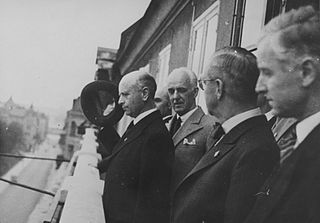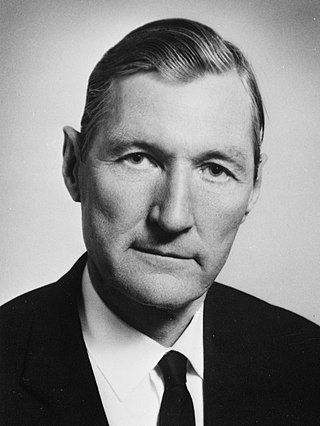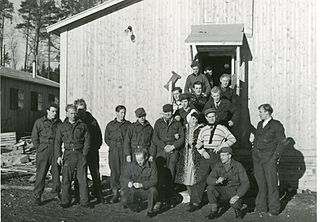Related Research Articles

The Norwegian Army is the land warfare service branch of the Norwegian Armed Forces. The Army is the oldest of the Norwegian service branches, established as a modern military organization under the command of the King of Norway in 1628. The Army participated in various continental wars during the 17th, 18th, and 19th centuries as well, both in Norway and abroad, especially in World War II (1939–1945). It constitutes part of the Norwegian military contribution as a charter member of the North Atlantic Treaty Organization (NATO) since 1949.

The Norwegian Armed Forces is the military organization responsible for the defence of Norway. It consists of five branches, the Norwegian Army, the Royal Norwegian Navy, which includes the Coast Guard, the Royal Norwegian Air Force, the Home Guard, and Norwegian Cyber Defence Force as well as several joint departments.

The Norwegian campaign involved the attempt by Allied forces to defend northern Norway coupled with the resistance of the Norwegian military to the country's invasion by Nazi Germany in World War II.
Milorg was the main Norwegian resistance movement during World War II. Resistance work included intelligence gathering, sabotage, supply-missions, raids, espionage, transport of goods imported to the country, release of Norwegian prisoners and escort for citizens fleeing the border to neutral Sweden.
XU was a clandestine intelligence organisation working on behalf of Allied powers in occupied Norway during World War II. Though its work proved invaluable for operations against German operations in Norway, most of its operations, organization, etc., were kept secret until 1988.
The phrase high command may refer to:
Vera Margrethe Henriksen was a Norwegian novelist, playwright, and non-fiction writer. She was particularly known for her historical novels and plays set in the Middle Ages.

Heinrich Fehlis was a German Schutzstaffel (SS) officer during World War II. He commanded the Sicherheitspolizei (SiPo) and Sicherheitsdienst (SD) in Norway and Oslo during the German occupation of Norway.
Leif Hans Larsen Tronstad DSO, OBE was a Norwegian inorganic chemist, intelligence officer and military organizer. He graduated from the Norwegian Institute of Technology in 1927 and was a prolific researcher and writer of academic publications. A professor of chemistry at the Norwegian Institute of Technology from 1936, he was among the pioneers of heavy water research, and was instrumental when a heavy water plant was built at Vemork.

The Norwegian Legation in Stockholm played a significant role during the Second World War. Until 9 April 1940 the legation consisted of four persons, and at the end of the war about 1,100 persons were connected to the legation. Refugee cases were among the legation's most central tasks. In 1941 a military office was established, and this was later split into separate offices for intelligence, and for Milorg related cases.
Bjørn Arnold Rørholt was a Norwegian engineer, military officer, Secret Intelligence Service agent and resistance member during World War II.
RMO was a Norwegian clandestine organization for naval intelligence during World War II, led from Oslo. The organization operated from Spring 1942 until the end of the war in the spring of 1945.

The Quisling regime, or Quisling government are common names used to refer to the fascist collaboration government led by Vidkun Quisling in German-occupied Norway during the Second World War. The official name of the regime from 1 February 1942 until its dissolution in May 1945 was Den nasjonale regjering. Actual executive power was retained by the Reichskommissariat Norwegen, headed by Josef Terboven.

Johannes Bratt Andenæs, often shortened to Johs. Andenæs was a Norwegian jurist. He was a professor of jurisprudence at the University of Oslo from 1945 to 1982, and served as rector from 1970 to 1972.

The Norwegian police troops in Sweden during World War II consisted of around 15,000 men, recruited from Norwegian refugees and trained at a number of secret camps in Sweden.
Ragnvald Alfred Roscher Lund was a Norwegian military officer, with the rank of colonel.
Kristian Rikardsen Løken was a highly decorated Norwegian military officer who served in the Belgian Force Publique from 1907 to 1917, fighting German colonial forces in East Africa from 1914 to 1917, and went on to command a Norwegian Army infantry brigade during the 1940 Norwegian campaign of the Second World War.
Andreas Kielland Rygg was a Norwegian military officer.
Jakob Schive was a Norwegian military officer, geodesist and Milorg pioneer.
Niels Larsen Bruun was a Norwegian officer who served in the Royal Norwegian Navy for more than four decades. Bruun took part in neutrality protection duties during the First World War, seeing service on several naval vessels and assuming his first command. He continued his service in the inter-war years, teaching at naval schools in addition to shipboard service.
References
- ↑ "Forsvarets overkommando". Store norske leksikon (in Norwegian). Oslo: Kunnskapsforlaget. Retrieved 24 October 2010.
- 1 2 Nøkleby, Berit (1995). "Forsvarets Overkommando, FO". In Dahl; Hjeltnes; Nøkleby; Ringdal; Sørensen (eds.). Norsk krigsleksikon 1940-45 (in Norwegian). Oslo: Cappelen. pp. 114–115. ISBN 82-02-14138-9.
- 1 2 Njølstad p.145